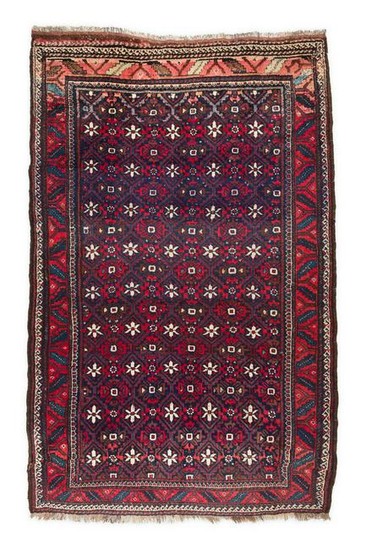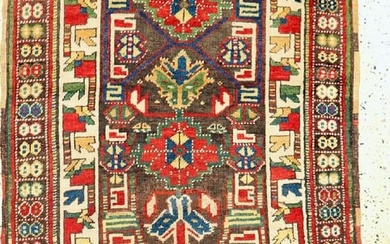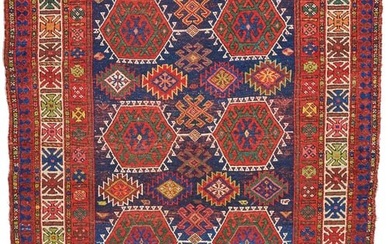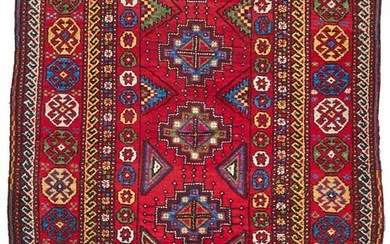Kurdish 237 X 153 cm
Origin: Northwest Persia
Size: 237 x 153 cm (Approximately 93.3 X 60.2 inch)
Age: Mid 20th century
Knots: 5 x 5 = 25 knots per sq cm
Condition: Full pile, has natural wool abrash
Description of Design and History:
Kurdish rugs are as diverse as the ethnic weavers who created them. The presence of Kurdish weavers in the northwestern area of Persia and the Iranian Kurdistan region has led to some stylistic overlap. Antique Kurdish rugs are one of the few under-recognized rug types to emerge in the past 30 years. Kurdish groups traditionally populated the eastern edge of Turkey, northern Iraq, western Persia and small areas near Persiaâ„¢s eastern borders. Although these antique Kurdish village carpets feature motifs that are reminiscent of Caucasian designs, Kurdish weavers were a very small minority in areas north of Persia.
As their designs reflect, Kurdish weavers arenâ„¢t part of a homogeneous group. There are many clans and sub-groups, such as the Jaff and Sanjabi, who produce individual designs. Antique Kurdish rugs feature elegant curvilinear shrubs, superb Herati motifs, Memling guls and exquisite floral. Their style ranges from formal to whimsical. The designs are varied and the colors are exuberant. The rug patterns and symbols used by Kurdish weavers have been absorbed by neighboring weavers and have become part of the larger culture. From the graphic style and the fine fleece to the beautiful colors and iconic patterns, antique Kurdish rugs have innumerable traits that make them highly desirable.
Kurdish Rugs: Long mistaken as Northwest Persian or Caucasian village weaving of indeterminate type, antique Kurdish rugs and carpets have only recently come to be recognized for their distinctive sense of design and fine color. Many of those produced in the Sauj Bulagh region are extremely early, possibly dating before 1800. Kurdish rugs were produced in medallion patterns and more commonly in allover designs, either floral, Mina-Khani patterns, or geometric, like the so-called Å“Jaff type. The color of Kurdish rugs is at times astounding, with transparent terracotta and burnt orange tones, gorgeous blues and greens, and vibrant saffron yellows. These color effects are greatly enhanced by the lustrous, silky wool that Kurdish weavers commonly used.All natural dyes are paramount for the carpet to have more than just decorative value. Beyond that, various dyers had varying levels of skill and invested different lengths of time in dyeing the yarns. The Å“quality of color“its radiance and level of nuance within each color“is centrally important. Certain rare colors such as Tyrian purple, saffron yellow, cochin
Condition Report: The absence of a condition report does not imply that the lot is in perfect condition. Please carefully read our terms of sale, shipping pick up & payment information. We are happy and willing to answer questions about any of our lots as well as to send additional images. It is the responsibility of the bidder to pose any questions BEFORE bidding. Please email us for a shipping quote if needed. All sales are final.
View it on
Estimate
Time, Location
Auction House
Origin: Northwest Persia
Size: 237 x 153 cm (Approximately 93.3 X 60.2 inch)
Age: Mid 20th century
Knots: 5 x 5 = 25 knots per sq cm
Condition: Full pile, has natural wool abrash
Description of Design and History:
Kurdish rugs are as diverse as the ethnic weavers who created them. The presence of Kurdish weavers in the northwestern area of Persia and the Iranian Kurdistan region has led to some stylistic overlap. Antique Kurdish rugs are one of the few under-recognized rug types to emerge in the past 30 years. Kurdish groups traditionally populated the eastern edge of Turkey, northern Iraq, western Persia and small areas near Persiaâ„¢s eastern borders. Although these antique Kurdish village carpets feature motifs that are reminiscent of Caucasian designs, Kurdish weavers were a very small minority in areas north of Persia.
As their designs reflect, Kurdish weavers arenâ„¢t part of a homogeneous group. There are many clans and sub-groups, such as the Jaff and Sanjabi, who produce individual designs. Antique Kurdish rugs feature elegant curvilinear shrubs, superb Herati motifs, Memling guls and exquisite floral. Their style ranges from formal to whimsical. The designs are varied and the colors are exuberant. The rug patterns and symbols used by Kurdish weavers have been absorbed by neighboring weavers and have become part of the larger culture. From the graphic style and the fine fleece to the beautiful colors and iconic patterns, antique Kurdish rugs have innumerable traits that make them highly desirable.
Kurdish Rugs: Long mistaken as Northwest Persian or Caucasian village weaving of indeterminate type, antique Kurdish rugs and carpets have only recently come to be recognized for their distinctive sense of design and fine color. Many of those produced in the Sauj Bulagh region are extremely early, possibly dating before 1800. Kurdish rugs were produced in medallion patterns and more commonly in allover designs, either floral, Mina-Khani patterns, or geometric, like the so-called Å“Jaff type. The color of Kurdish rugs is at times astounding, with transparent terracotta and burnt orange tones, gorgeous blues and greens, and vibrant saffron yellows. These color effects are greatly enhanced by the lustrous, silky wool that Kurdish weavers commonly used.All natural dyes are paramount for the carpet to have more than just decorative value. Beyond that, various dyers had varying levels of skill and invested different lengths of time in dyeing the yarns. The Å“quality of color“its radiance and level of nuance within each color“is centrally important. Certain rare colors such as Tyrian purple, saffron yellow, cochin
Condition Report: The absence of a condition report does not imply that the lot is in perfect condition. Please carefully read our terms of sale, shipping pick up & payment information. We are happy and willing to answer questions about any of our lots as well as to send additional images. It is the responsibility of the bidder to pose any questions BEFORE bidding. Please email us for a shipping quote if needed. All sales are final.







